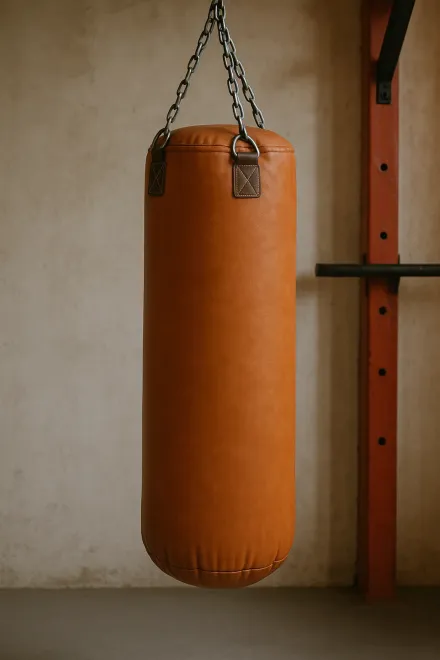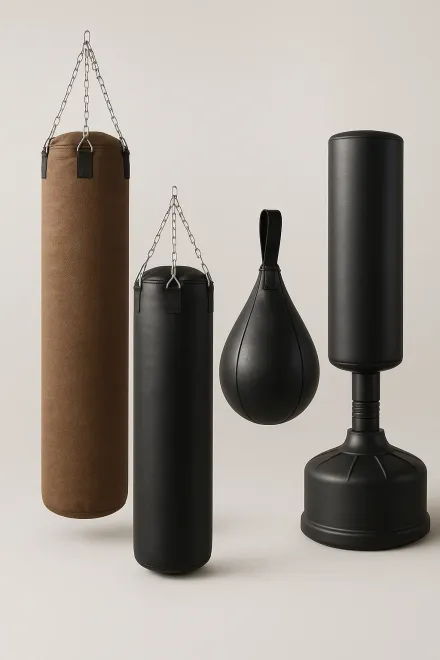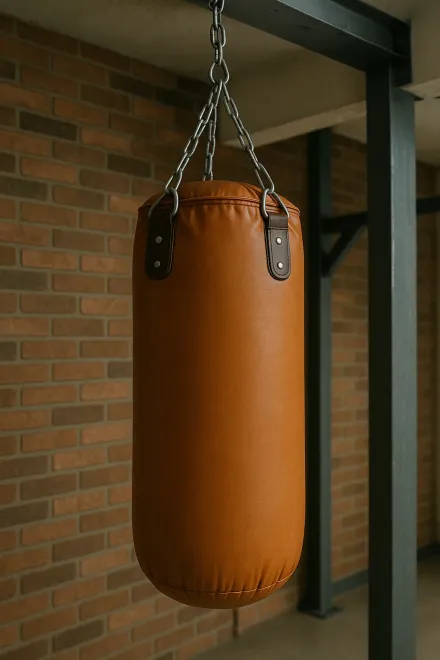Pre-filled punching bags
Pre-filled punching bags are one of the most practical tools for those who want to train at home or in the gym without hassle. Unlike empty bags, which require finding the right filling materials, these models come ready to use, with balanced density and consistency to withstand heavy punches and kicks. This makes them ideal for both beginners and more advanced boxers, as they save time and deliver a more realistic, comfortable training experience from day one.
See pre-filled punching bags on Amazon
Benefits of buying a pre-filled punching bag
Choosing a pre-filled punching bag brings several advantages over empty models. First, convenience: you will not need to hunt for filling materials like fabric scraps, sand, or foam, saving significant time and effort. In addition, coming pre-filled means manufacturers ensure uniform density that is suitable for training impacts. This results in greater joint safety and a more realistic feel on contact.
Another important advantage is durability. Since they are professionally filled, bags retain their shape better over time, preventing dips or irregular spots that can appear in poorly home-filled bags. They are also more practical for limited spaces, as you can hang them right out of the box and start training without complications.
In short, if you want convenience, toughness, and performance from the first use, investing in a pre-filled punching bag is an excellent decision.
Types of filled punching bags available
On the market you will find different types of filled punching bags, each designed for a specific training style. For example, long cylindrical bags are ideal for practicing both punches and kicks in sports like muay thai or kickboxing.
Shorter bags, by contrast, are aimed at classic boxing, letting you focus power on the upper body.
There are also tear-drop bags, which are wider at the base and help you drill hooks and uppercuts. Another interesting option is free-standing filled bags with a base, which do not require ceiling installation and are perfect for those who do not want to drill at home.
The cover material also varies: synthetic leather for higher resistance and durability, canvas for a more budget-friendly price, or reinforced vinyl for intense training. The choice will depend on your use case and budget.
Knowing these options will help you choose the bag that best suits your needs and training style.


How to choose the best filled punching bag
To choose the best pre-filled punching bag, it is important to consider several key factors.
First, the bag's weight. Lighter models, between 20 and 30 kg, are suitable for beginners and recreational training, while 40 kg or more is recommended for those seeking greater resistance and a more realistic hit.
Another aspect to weigh is the type of filling. Some bags combine fabric shreds with sand for a firmer feel, while others use compressed foam to reduce joint impact. The quality of stitching and the reinforcements at the top are also relevant, as they determine the bag's durability.
If you will train at home, make sure you have a suitable space to hang it, or consider a base-mounted model with a stand. Lastly, think about your discipline: if you practice pure boxing, a classic cylindrical bag is enough; but if you train mixed martial arts, a longer bag that lets you drill low kicks could be better.
Evaluating these points will help you invest in a bag that truly fits your goals and stays with you for a long time.
Training tips with filled punching bags
Training with a filled punching bag is an excellent way to improve fitness, technique, and power. However, to get the most from it, follow a few practical tips. First, always use boxing gloves or wraps to protect your hands and wrists. Striking the bag bare-handed can cause long-term injuries.
Start with warm-up rounds to prep muscles and joints, and mix different strikes: straights, hooks, uppercuts, and kicks if your discipline allows. Do not just hit without a plan; work in 2–3 minute rounds with short rests to simulate a real fight. Also, focus on breathing and stance: keeping a firm guard and moving around the bag will boost coordination and defense.
Another key tip is to vary intensity. Alternate light shots to perfect technique with fast combos to improve speed. You can also add power-focused rounds, emphasizing stronger, sustained strikes. And if you like, complement your practice with strength and conditioning like push-ups, core work, or jump rope.
With consistency and solid planning, training with a filled bag can become the backbone of a complete program to elevate both your athletic performance and overall fitness.
Maintenance and care for a filled punching bag
One aspect many overlook when buying a filled punching bag is maintenance. Although designed to be tough, heavy use without proper care can shorten its lifespan. Start by regularly checking stitching and hang points. If you notice wear or loose threads, fix them immediately to avoid splits over time.
It is also advisable to rotate the bag occasionally, especially with daily use, to prevent the filling from compacting in one spot. If you notice loss of shape or firmness, some models let you open the top and redistribute material. In addition, wipe the surface with a damp cloth after each session to prevent sweat and bacteria buildup. For synthetic leather bags, using appropriate cleaners will help maintain material flexibility.
Another important tip is to protect the bag from direct sun and excessive humidity, as these factors can damage the outer cover. If you use a base bag filled with water or sand, check periodically for leaks.
With these basic steps, your pre-filled punching bag can last for years in top condition, delivering safe, effective training.
Frequently asked questions about pre-filled punching bags
What weight should a pre-filled punching bag have for beginners?
For those starting boxing or training recreationally, a bag between 20 and 30 kg is usually enough. This weight lets you work on technique without overloading joints and is easier to set up at home. As you gain strength and experience, you can move to 40 kg or more for greater resistance to impact.
Is a bag filled with fabric or sand better?
Bags filled with fabric offer a softer, more uniform strike, making them better for longer sessions and beginners. Bags that include sand are harder and heavier, ideal for those who want to simulate striking a real opponent and build power. The choice depends on your goals and experience level.
Can a pre-filled punching bag be used outdoors?
Yes, you can use a pre-filled punching bag outdoors, but protect it from rain, humidity, and direct sun, as these will degrade materials faster. Ideally, install it under a roof or covered area. It is also wise to clean it frequently to prevent dust and grime buildup.
What is the difference between a hanging filled bag and a base bag?
A hanging bag is the classic option and moves naturally on impact, helping you work mobility and timing. A base bag, by contrast, has a stand filled with water or sand and is more practical for small spaces or for those who do not want to drill ceilings or walls. Both serve the same purpose, but a hanging bag feels more realistic for simulating a bout.
How often should a pre-filled punching bag be replaced?
The lifespan of a pre-filled bag depends on training frequency and intensity, as well as material quality. Under normal conditions, a good bag can last 3 to 5 years. With proper care—cleaning and periodically rotating the fill—it can even exceed that without issues.
Is a pre-filled punching bag suitable for kickboxing or muay thai?
Yes, but in this case choose a longer bag that reaches the lower body. That way you can practice both punches and high and low kicks. Large, full-length cylindrical bags are best for these disciplines, while shorter models are designed mainly for traditional boxing.
How can I avoid injuries when using a pre-filled punching bag?
Always use gloves or wraps to protect hands and wrists, warm up before starting, and focus on clean technique with every strike. Begin with short rounds and progressively increase intensity. Keep proper posture and distribute body weight well to lower injury risk.
